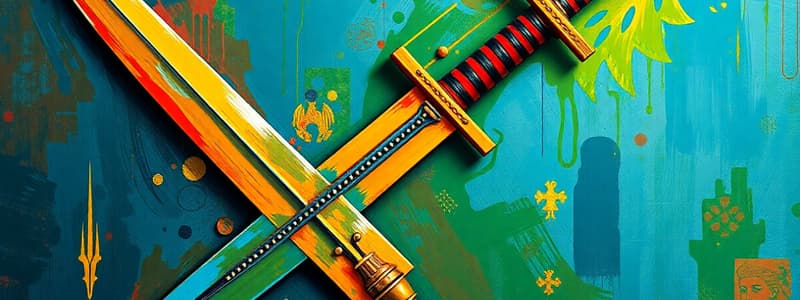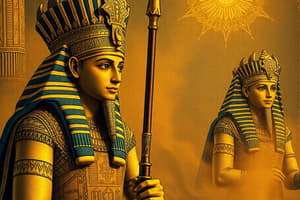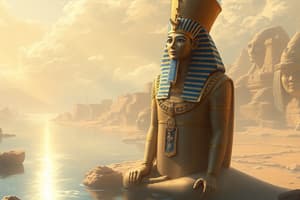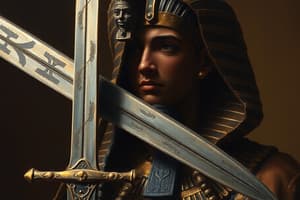Podcast
Questions and Answers
What conclusion can be reliably drawn based on the discovery of a bronze sword bearing the insignia of Ramses II within a military fort?
What conclusion can be reliably drawn based on the discovery of a bronze sword bearing the insignia of Ramses II within a military fort?
- Ramses II personally led military campaigns from this fort, using the sword in battle.
- The fort likely housed a high-ranking military official who received the sword as a symbol of royal favor. (correct)
- The sword was mass-produced in the fort's on-site weapons production area for distribution to the general populace.
- Bronze swords were the primary weapon used by all soldiers in Ramses II's army.
Considering the archaeological findings at Tell Al-Abqain, what does the presence of grain storerooms, ovens, and remains of fish and animal bones suggest about the fort's inhabitants?
Considering the archaeological findings at Tell Al-Abqain, what does the presence of grain storerooms, ovens, and remains of fish and animal bones suggest about the fort's inhabitants?
- The fort was primarily a trading outpost that relied on bartering food resources with other regions.
- The soldiers primarily relied on hunting expeditions outside of the fort for sustenance.
- The fort was a self-sufficient community capable of producing and storing its own food.
- The fort was part of a well-supplied trade route that provided variety to the soldier's diet. (correct)
What can be inferred from the presence of kohl applicators and bead necklaces within the military fort at Tell Al-Abqain?
What can be inferred from the presence of kohl applicators and bead necklaces within the military fort at Tell Al-Abqain?
- The fort was also used as a religious site where the soldiers would adorn statues of their gods.
- The kohl and necklaces were spoils of war brought back by the soldiers from conquered territories. (correct)
- The fort was inhabited by a large number of women and children related to the soldiers.
- The soldiers had certain personal grooming habits and potentially engaged in activities beyond military duties.
How does the discovery of the bronze sword, along with other findings, contribute to our understanding of Ancient Egyptian military forts like Tell Al-Abqain?
How does the discovery of the bronze sword, along with other findings, contribute to our understanding of Ancient Egyptian military forts like Tell Al-Abqain?
Given Peter Brand's theory and the archaeological evidence, what was the most likely purpose of presenting a high-ranking officer with a sword bearing Ramses II's insignia?
Given Peter Brand's theory and the archaeological evidence, what was the most likely purpose of presenting a high-ranking officer with a sword bearing Ramses II's insignia?
If a similar sword with the insignia of Ramses II was discovered in a tomb far from any known military installation, what alternate conclusion could be reasonably drawn about the sword's significance?
If a similar sword with the insignia of Ramses II was discovered in a tomb far from any known military installation, what alternate conclusion could be reasonably drawn about the sword's significance?
Based on the information provided, what conclusion can be made about the scale of Ramses II's building projects and territorial expansion?
Based on the information provided, what conclusion can be made about the scale of Ramses II's building projects and territorial expansion?
How would the discovery of detailed records of grain distribution within the fort change our understanding of the lifestyle in Tell Al-Abqain?
How would the discovery of detailed records of grain distribution within the fort change our understanding of the lifestyle in Tell Al-Abqain?
What is the most likely reason that two limestone blocks were found, one with the inscription “Bay” and the other with Ramses' name?
What is the most likely reason that two limestone blocks were found, one with the inscription “Bay” and the other with Ramses' name?
Considering the hot desert climate of Egypt, what was the primary function of the 'kohl' eyeliner used by ancient Egyptians, including the soldiers stationed at Tell Al-Abqain?
Considering the hot desert climate of Egypt, what was the primary function of the 'kohl' eyeliner used by ancient Egyptians, including the soldiers stationed at Tell Al-Abqain?
Flashcards
Ramses II Sword Discovery
Ramses II Sword Discovery
A gleaming bronze sword discovered in Egypt, bearing the insignia of Ramses II.
Tell Al-Abqain
Tell Al-Abqain
A 3,200-year-old military fort in northwest Egypt where the bronze sword was found.
Peter Brand
Peter Brand
Historian who theorized the sword was a royal gift to a high-ranking officer.
Kohl Eyeliner
Kohl Eyeliner
Signup and view all the flashcards
Ramses II
Ramses II
Signup and view all the flashcards
Engraved Sword
Engraved Sword
Signup and view all the flashcards
Storerooms and Ovens
Storerooms and Ovens
Signup and view all the flashcards
Study Notes
- A bronze sword with markings of Pharaoh Ramses II was discovered in Egypt on September 5, 2024.
- The sword was found at Tell Al-Abqain, a 3,200-year-old military fort in northwest Egypt.
- The sword bears the insignia of Ramses II, a powerful pharaoh of ancient Egypt.
- Despite being buried for over 3,000 years, the sword has retained its reflective shine.
- The sword was located inside a small room in one of the mud barracks surrounding the fort.
- The presence of Ramses II's emblem indicates the sword likely belonged to a prominent military official.
- Peter Brand, a historian, suggests the fort was well-defended, possibly with its own weapons production area.
- Brand believes the sword was likely a royal gift to a high-ranking officer to increase prestige and advertise the king's wealth and power.
- The excavations revealed storerooms for grain and ovens for baking, indicating a self-sufficient community.
- Remains of clay pots containing bones of fish and other animals were found, suggesting a varied diet.
- Bead necklaces and a kohl eyeliner applicator offer insights into the personal lives of the soldiers.
- Kohl, a black powder, was used by ancient Egyptians to protect their eyes from the desert sun.
- Two limestone blocks were discovered, one engraved with the name "Bay" and the other mentioning Ramses.
- Ramses II, also known as Ramses the Great, ruled for 66 years (1279-1213 BCE) as the third king of the 19th Dynasty.
- Ramses II significantly expanded Egypt's borders.
- Ramses II was known as the "builder pharaoh" due to the many temples and monuments he commissioned.
Studying That Suits You
Use AI to generate personalized quizzes and flashcards to suit your learning preferences.





